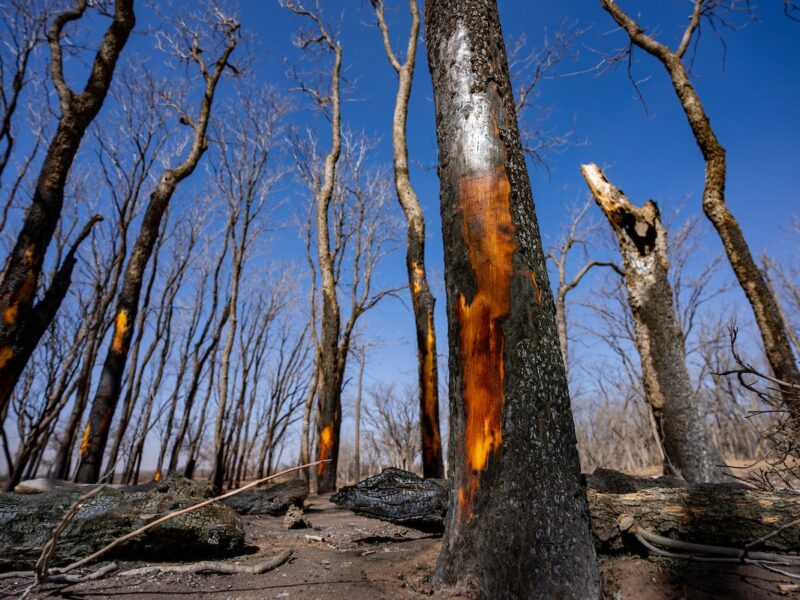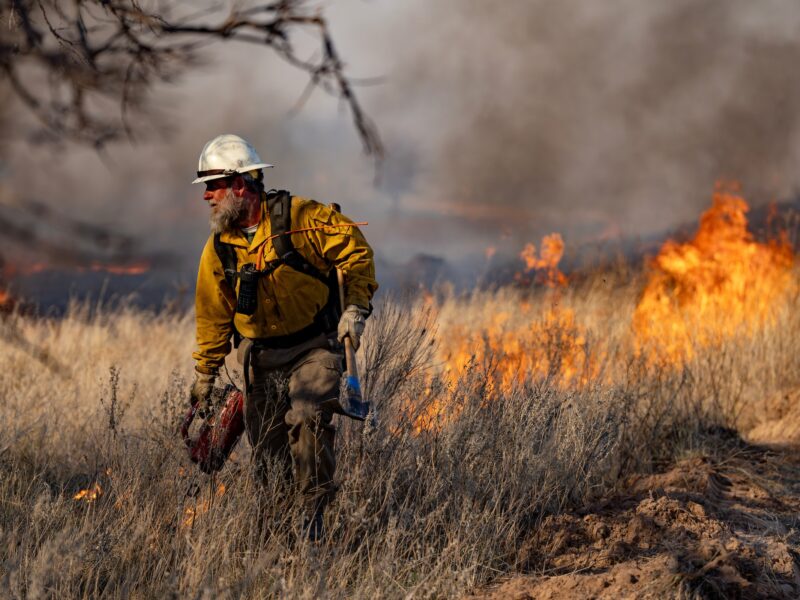At Texas A&M Forest Service Headquarters, Staff Play Critical Role In Battling Historic Wildfires
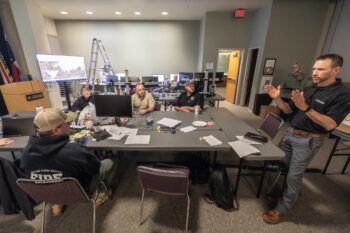
On a recent afternoon in South College Station, Texas A&M Forest Service Fire Chief Wes Moorehead stood at a conference table in the agency’s headquarters, talking through the latest developments in the devastating wildfires scorching large swaths of the Panhandle.
Topics of discussion included current conditions on the ground, weather forecasts for affected areas, and the continued need to support firefighters’ mental health while they’re in the field. Near the front of the room, a screen displayed a continuously updated map showing where the fires were burning, using data from aircraft, satellites and personnel on the ground. It’s here at the Emergency Operations Center roughly 500 miles away from the Panhandle that Forest Service personnel have been working overtime coordinating the massive effort to contain the largest wildfire in the state’s history.
Last week, the Forest Service’s law enforcement investigators concluded that the Smokehouse Creek fire, which has torched more than 1 million acres, and the nearby Windy Deuce fire, which has burned 144,000 acres, were both caused by power lines. The former has killed two people since it was ignited on Feb. 26.
“It’s just slightly bigger than the state of Rhode Island,” Moorehead said of the historic Smokehouse Creek fire. “When you’re talking about a fire of this size and complexity, and you’re having to suppress that wildfire and get crews in place to stop it, that’s a significant undertaking.”
In total, about 600 personnel have been deployed to the Panhandle by the Forest Service, the Texas Intrastate Fire Mutual Aid System, the Texas All-Hazard Incident Management Team, and organizations from other states.
One vital part of the massive firefighting effort is the behind-the-scenes work being performed in College Station, where staff process up to-the-minute information about the fires and decide where to direct crews, equipment and other resources. Data gathered in the field is relayed back to staff at the Emergency Operations Center, where critical decisions are made, Moorehead explained.
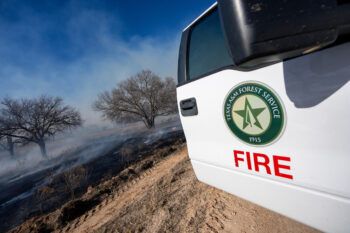
When responding to a fire of this size, Moorehead said it’s crucial to direct resources to the areas where they will do the most good, protecting people and homes first, while also making an effort to save other property, livestock and natural resources.
Even with responders pouring in from local fire departments and other organizations from across Texas and beyond, it can be a difficult puzzle to solve, said Jake Donellan, Field Operations Department Head. Fortunately, the team members in College Station — many of whom began their careers fighting fires in the field — have the knowledge and experience to make the right calls, he said.
“In the field, your mental challenge is to keep focused on the fire, keep focused on safety, and keep focused on progressing,” Donellan said. “Here, the mental challenge is on the decision making and prioritization.”
As emergency response efforts continue, Texas A&M Forest Service Director Al Davis said he remains proud of the work being done throughout the agency to keep Panhandle residents safe.
“The men and women of this agency have a tremendous responsibility to help protect Texas when wildfires and other all-hazard disasters occur,” Davis said. “From tactical boots-on-the-ground strategic and timely positioning, to allocating of response resources, it takes a large, highly trained and well-coordinated team.”
‘A Big Chess Game’
After two weeks of battling the Panhandle fires, Donellan and Moorehead say the tide has started to turn. As of Monday, the Smokehouse Creek fire is more than 85% contained and is no longer an immediate threat to surrounding communities, Moorehead said.
“The intel we’re getting is that the fire is, for the most part, out.” There are a couple of remaining “hot spots” he said, but one characteristic of fires in the Panhandle is that they typically consist of large swaths of dry grass, which burn rapidly and don’t retain much heat. “Once it’s out, it’s out,” Moorehead said.
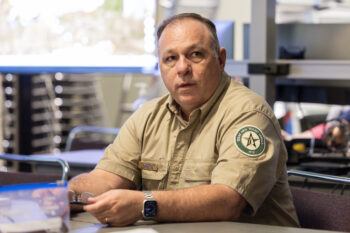
With the fires coming under control, Moorehead said attention is shifting to recovery, as agencies such as the Texas A&M AgriLife Extension Service help families and communities start to rebuild. The Forest Service will also begin repositioning some resources in preparation for future ignitions, Donellan said.
“As we see that the threat is not as great on this part of the state, we start reallocating resources to parts of the state that are threatened,” Donellan said. “It’s sort of like a big chess game where you’re moving your pieces across the board to try and address the next incoming threat.”
For this task, the agency relies heavily on its predictive services department, which monitors an extensive network of 150 weather stations — unmanned devices that record and transmit weather data such as temperature, humidity and wind speed in a given area. The allows the agency to maintain an accurate picture of weather conditions across the state and identify potential trouble spots.
“Around the clock, our predictive services department is monitoring weather and fuel conditions. Fuel is anything that will burn out there in the wildland landscape,” Moorehead said. Prior to the Panhandle wildfires, “they alerted us that the conditions were elevated and that we had a chance for a larger fire, and so we actually prepositioned some additional resources in that area.”
This allows the agency to be as effective as possible with the resources it has, Moorehead said, ultimately leading to more lives and homes saved across the state.
“When we have a good day, and we know we helped protect a community, we have a lot of pride in the actions the men and women took out there,” Moorehead said. “The forecast was right, the resources were applied in the right spot, and we absolutely go home that day knowing that there are homes saved because of all the first responders that were on scene.”
Media contact: Erin O’Connor, eoconnor@tfs.tamu.edu
